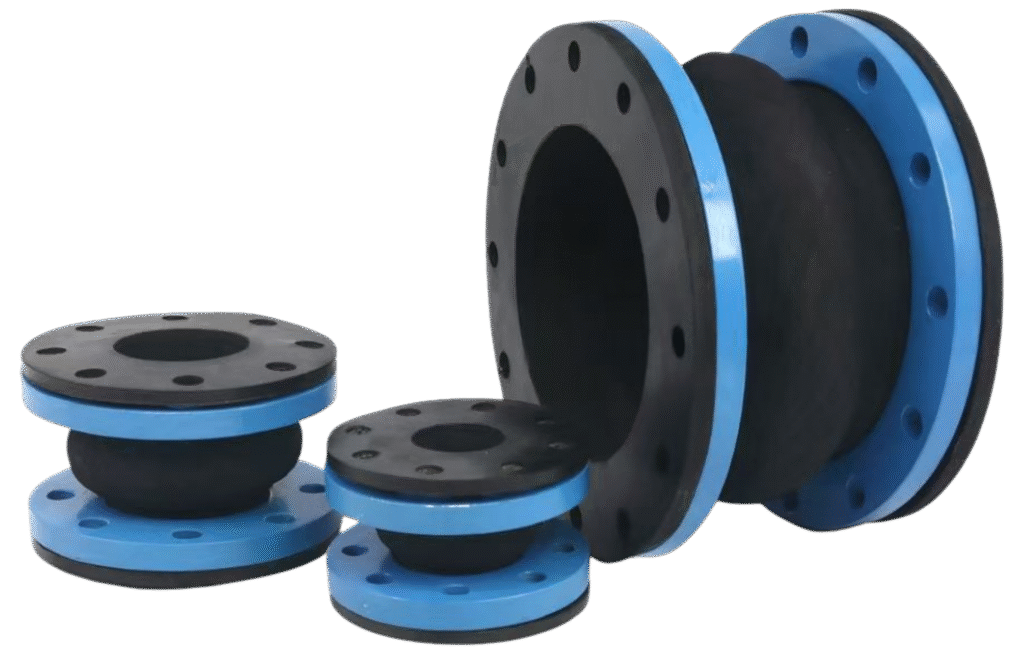Non-metallic Expansion Joint for Gas Turbine Diffuser
Home > Non-metallic Expansion Joint for Gas Turbine Diffuser
Non-metallic Expansion Joint for Gas Turbine Diffuser
Our fabric (non-metallic) expansion joints are specially designed for gas turbine diffuser systems operating under high temperature and pressure pulse conditions. They feature a multi-layer textile structure that ensures excellent flexibility, high temperature resistance, and reliable sealing performance. By compensating for thermal expansion, vibration, and installation tolerances, these joints effectively reduce stress concentration, protect connected equipment, and guarantee long-term operational safety.
Smoke Extraction Fan Expansion Joint – High-Temperature, Self-Sealing Fabric Design
Overview:
Our smoke extraction fan expansion joints are specially designed for high-temperature applications, providing reliable vibration compensation and sound isolation in smoke extraction systems for buildings and tunnels. These joints are suitable for both round and rectangular duct cross-sections and can be tailored to your specific installation requirements.
Key Features:
Design: Straight or conical fabric expansion joints, silicon-free, with self-sealing full-faced flanges.
Flanges: Single-part backing flange on both sides ensures secure and leak-proof installation.
Test Temperature: Tested for continuous operation at 600°C for 120 minutes.
Test Vacuum: 1,500 Pa at room temperature; 500 Pa at 600°C.
Installation Method: Fixed to flanges at duct level for easy integration.
Dimensions: Suitable for round and rectangular ducts; installation length from 100 mm to 250 mm.
Media Temperature: Long-term operation up to 120°C.
Pressure Resistance: Up to ±15,000 Pa at room temperature.
Movement Capability: Accommodates both axial and lateral movements, with axial compression up to 50 mm and lateral displacement up to 20 mm.
Applications:
Ideal for automatic smoke extraction systems in buildings and tunnels, providing vibration compensation, noise reduction, and safe smoke evacuation under high-temperature conditions.
Expansion Joint Flanges and Flow Liners – Materials, Design, and Accessories
Flanges Design:
Type: Single-part backing flange with clearance holes for easy installation.
Standards: Designed according to the usual norms for ventilation systems.
Materials: Carbon steel or stainless steel.
Coating Options: Primed, hot-dip galvanised, or special paint for enhanced corrosion resistance.
Flow Liners Design:
Type: Cylindrical, conical, or telescoping (detailed designs > page 360).
Materials: Carbon steel or stainless steel.
Coating Options: Primed, hot-dip galvanised, or special paint.
Optional Accessories:
Support Rings: For enhanced stability and alignment.
Cross Section: BGS600 S21.
Vacuum Ring: Made from spring steel to ensure durability under negative pressure.
Overview:
These expansion joint components are designed for ventilation and smoke extraction systems, offering reliable performance, ease of installation, and long-term durability. Flanges and flow liners can be customised according to project requirements, with a variety of materials and coatings to suit different operating environments.
Expansion joints for smoke extraction and ventilation
| Name | Description | Pressure | Temperature / Smoke Test | Movement Capability |
|---|---|---|---|---|
| Smoke extraction fan expansion joint with self-sealing full-faced flanges | Round or rectangular duct cross-section | Up to ±15,000 Pa | 120 min smoke extraction at 600°C | Axial and lateral |
| Smoke extraction single-arch ducting expansion joint with vacuum ring and self-sealing full-faced flanges | Round or rectangular duct cross-section | Up to ±15,000 Pa | 120 min smoke extraction at 600°C | Axial and lateral |
| Fan or ducting expansion joint with self-sealing full-faced flanges for ventilation and air conditioning systems | Round or rectangular duct cross-section | Up to ±15,000 Pa | -60 to +200°C (peaks up to 250°C) | Axial and lateral |
| Conductive fan or ducting expansion joint with explosion protection and self-sealing full-faced flanges | Round or rectangular duct cross-section | Up to ±15,000 Pa | -30 to +100°C | Axial and lateral |
What is a Fabric Expansion Joint?
A Fabric Expansion Joint is a highly flexible component made from textile fibers, classified under non-metallic expansion joints. Unlike metal or rubber expansion joints, it is specifically designed for gaseous media and is not suitable for pipelines carrying liquids. Its unique multi-layer construction allows it to withstand extremely high temperatures, often exceeding 1000°C, while maintaining flexibility and reliability under thermal expansion, vibration, and structural movement.
Each layer of a fabric expansion joint is engineered for a specific purpose: some resist high temperatures, others protect against corrosion from process gases, and some retain pressure. By combining multiple layers into a stratified structure, the joint can meet demanding project requirements while adapting to diverse operating conditions.
When installed in a duct or pipeline system, a fabric expansion joint compensates for dimensional changes caused by thermal expansion, acts as a flexible connection between equipment and piping, and reduces stress concentration at rigid interfaces. Its construction typically includes flexible fabric, flanges or weld ends, and tie rods with nuts, allowing significant axial, lateral, and angular deflection within a compact space, without generating reaction thrust.
Advantages of Fabric Expansion Joints
Fabric expansion joints offer multiple benefits that make them ideal for industrial applications:
Thermal Expansion Compensation: They provide significant movement accommodation within limited space, preventing damage from thermal stress.
Installation Error Compensation: The flexible design can absorb minor misalignments during pipe assembly, ensuring smooth operation.
Vibration and Noise Reduction: Fibrous materials and insulating layers absorb vibration and reduce noise from fans, boilers, and other equipment.
No Reaction Thrust: Unlike metal joints, they do not transmit significant forces, simplifying structural design.
High Sealing Performance: Fabric joints maintain airtight connections under high-temperature gas flows and are easy to install, repair, or replace.
Durability and Maintenance: Resistant to high temperatures, corrosion, and chemical exposure, while being simple to maintain or replace when needed.
Applications of Fabric Expansion Joints
Fabric expansion joints are widely used across multiple industries due to their versatility and performance:
1. Thermal Power Plants
Commonly installed in:
Flue Gas Desulfurization (FGD) and DeNOx systems
Circulating Fluidized Bed (CFB) boilers
Bottom ash discharge lines
Economizer outlets
Air preheater inlet and outlet
Electrostatic precipitator (ESP) inlet and outlet
Chimney pipe systems
Fan and coal mill inlets/outlets
Seals between cross-wall pipes and walls
2. Wind Power
Fabric joints are installed between cooling water ducts and the nacelle cover, air heat exchangers and nacelle cover, and nacelle cover to plate-type heat exchangers. They ensure sealing during vibration displacement and compensate for minor installation deviations. This solution is extensively used in 3MW offshore and onshore units of major wind turbine manufacturers.
3. Metallurgy
Applications include:
General piping and branch pipes of sintering systems
FGD and dry dust removal systems
Fan inlets and outlets
Chimney inlets
Material conveying systems
Waste heat recovery systems
Iron pre-treatment and converter cooling flue systems
Heating furnaces, hot air ducts, flue pipes, and exhaust systems for copper, aluminum, zinc, and tin smelting
4. Cement Industry
Used in rotary kiln production lines for:
Raw material grinding
Cement milling systems
Cyclone preheating systems
Clinker burning and cooling systems
Dust remover inlets and outlets
Waste gas treatment systems
Fan inlets and outlets
Pipes transporting air, gas, and gas with powder
5. Refinery and Chemical Industry
Commonly applied to:
Combustion furnaces and boiling reactors
Boiler and energy recovery systems
Heat exchangers and preheating systems
Environmental protection and cleaning systems
Fan inlets/outlets and process pipelines
6. Other Industries
Fabric expansion joints are also widely used in:
Waste incineration plants
Ships
Buildings
Paper industry
Construction
Nuclear power
All expansion joint products can be customized according to actual project requirements, including dimensions, materials, temperature range, and accessory configuration, to meet the specific installation and operational needs of different duct systems.


